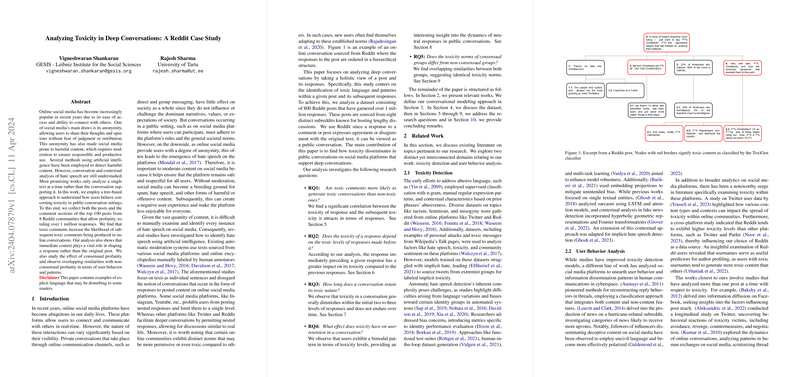Insights into Toxicity Dynamics in Online Conversations: A Reddit Analysis
The paper "Analyzing Toxicity in Deep Conversations: A Reddit Case Study" provides an in-depth examination of the proliferation of toxic language in online public discussions, utilizing Reddit as the foundation for its paper. The analysis is administered through a tree-based approach, allowing for the assessment of user behaviors and the dynamics of toxicity within public conversations. By focusing on eight Reddit communities that welcome profanity, the research encompasses over one million responses to understand the propagation and impact of toxicity in these spaces.
Contextual and Temporal Dimensions of Toxicity
A central observation from the paper is the correlation between initial toxic responses and the subsequent perpetuation of toxicity through the thread. Toxic comments often spawn further toxic responses, leading to a potential cascade of negativity. This correlation is quantified by a moderate and statistically significant correlation coefficient of around 0.631, signifying that while not all comments engender toxicity, there is a discernible association favoring its proliferation.
To explore the complexities of conversational context, the paper examines the effect of preceding comments on the toxicity of subsequent responses. Interestingly, it is the immediate predecessor response that significantly impacts the toxicity level of a given comment, highlighting the importance of local context over broader discourse patterns. Toxicity in conversations tends to diminish after the initial few levels, further indicating that such exchanges are usually short-lived in terms of toxic interactions.
User Behavior in Toxic Environments
The investigation into user participation amidst toxic discussions reveals an intriguing dichotomy. There is a bimodal distribution in user responses where both highly toxic and completely non-toxic comments tend to drive more engagement than those with moderate toxicity levels. This suggests that while users may be deterred by moderately toxic exchanges, they are more likely to engage in highly polarized discussions, perhaps due to the inherent contentiousness that drives communication in polarized environments.
Comparative Analysis of Consensual and Non-consensual Toxicity
By analyzing a subreddit dedicated to consensual roasting, the research explores whether toxic behaviors differ in settings where such language is anticipated and embraced. The findings suggest that the dynamics of toxicity in consensual contexts are remarkably similar to those found in non-consensual settings. This parallel indicates a robust pattern of toxic interaction that transcends the expectation of profanity, suggesting that the mechanics of toxic language propagation remain consistent irrespective of user consent to participate in such exchanges.
Implications and Future Directions
The implications of these findings are multifaceted. They highlight the necessity for social media platforms to develop more nuanced models for moderating toxic content, taking into account not just the text itself but the context and conversation structure in which it occurs. Moreover, the results may guide future AI developments in social media moderation, wherein detecting and mitigating toxicity would benefit from understanding its conversational dynamics.
Additionally, further exploration into user engagement patterns in the presence of toxicity might unveil strategies to promote healthier interactions. This would ideally involve developing interventions that not only identify toxicity but also encourage users to disengage from destructive exchanges in favor of constructing positive dialogue.
The foundational characteristics of toxicity in public conversations depicted in this case paper extend the understanding of content dynamics on platforms like Reddit. As these platforms continue to serve as significant arenas for public discourse, insights derived from such research are crucial for fostering productive and respectful online interactions.
